I’ve always been fascinated by the ancient Roman Empire, and thanks to the “thinking about the Roman Empire” meme, I’ve discovered I’m not alone! Growing up, I lived not far from the Roman ruins at Hadrian’s Wall and dreamed of seeing the Colosseum in Rome and the ancient city of Pompeii.
While the Roman Empire may have fallen centuries ago, its legacy still lives on in the form of breathtaking Roman ruins scattered across Europe and beyond. One of the best things about visiting ancient ruins is that you can so often get up close with them; at the Roman sites in this list you can walk Roman streets, visit Roman amphitheatres and even bathe as the Romans did.
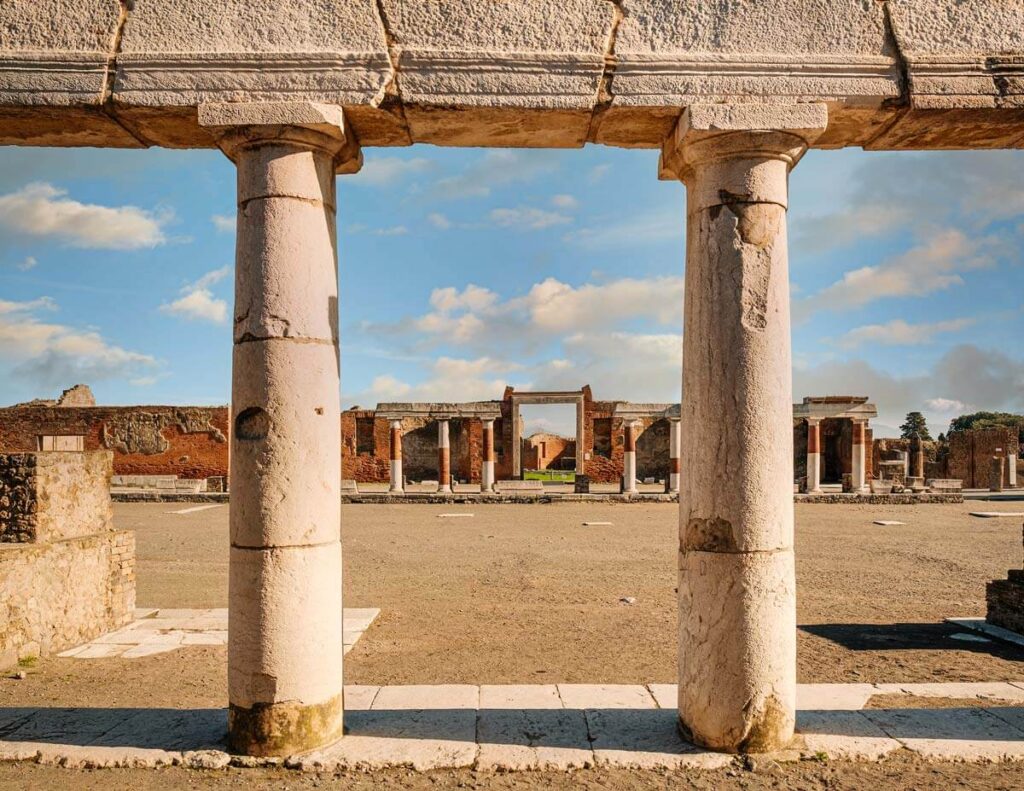
In this post I’ve rounded up some of my favourite ancient Roman sites to visit in Europe, along with a few that are on my bucket list. I hope you find it inspiring – and please tell me about your trips to Roman sites in the comments!
Roman sites to visit in Italy
If you’re interested in the best Roman ruins to visit, you have to start in Italy. You can see Roman history all across Italy, but let’s start in Rome, as the place where it all began.
The Colosseum, Rome
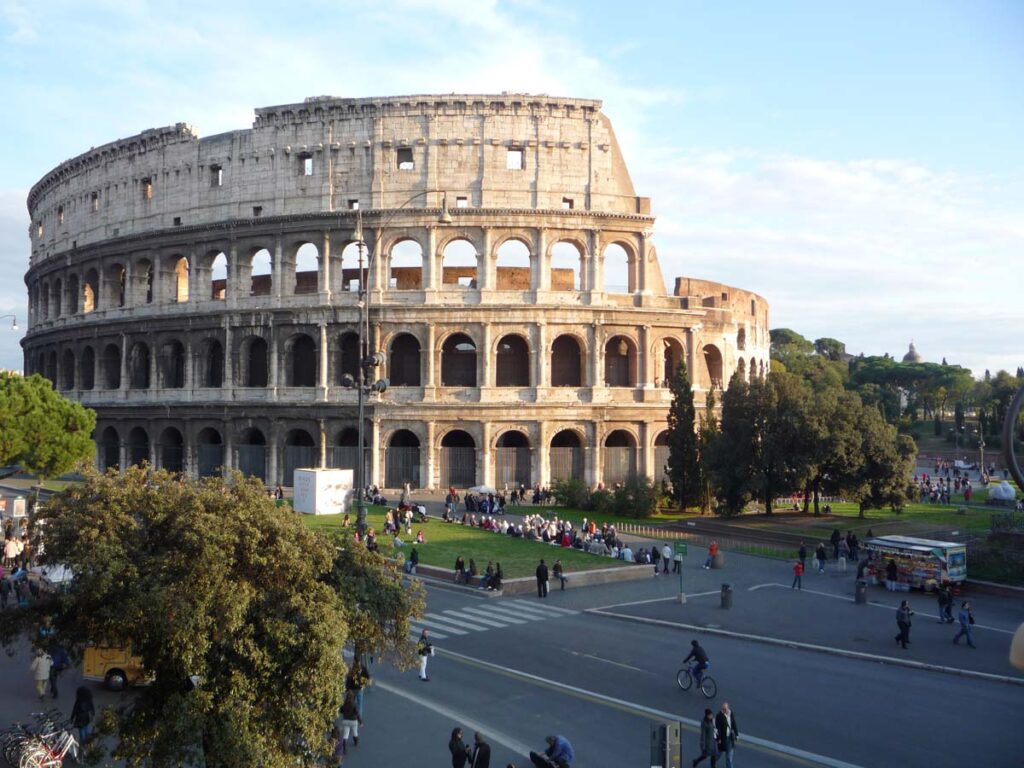
The mighty Colosseum in Rome is the Roman site that jumps straight to mind when I think about the Roman Empire. This colossal amphitheater was built in 70-80 AD under the reigns of the emperors Vespasian and Titus and could hold up to 50,000 spectators, who came to watch gladiatorial games, public spectacles, and dramas based on Classical mythology. As you walk through its arches, corridors and underground tunnels you can imagine the roar of the crowds and the heat of the battles that once took place here.
As the most famous Roman ruin and one of Rome’s most popular attractions, it’s a good idea to book your visit to the Colosseum well in advance. A guided tour, which often includes the nearby Forum and the Palatine Hill, will help you get the most from your visit.
Roman Forum, Rome
Just across the road from the Colosseum, the Roman Forum was once the hub of Roman public life and is another of the most important Roman sites in Rome. Visiting the Roman Forum lets you wander among the ruins of government buildings and ancient temples and stroll down shopping streets, just as the Roman people would have done thousands of years ago.
Like the Colosseum, the Forum fell into disrepair after the fall of the Roman Empire and was heavily plundered for its stone, leaving the famous Roman ruins that you see today.
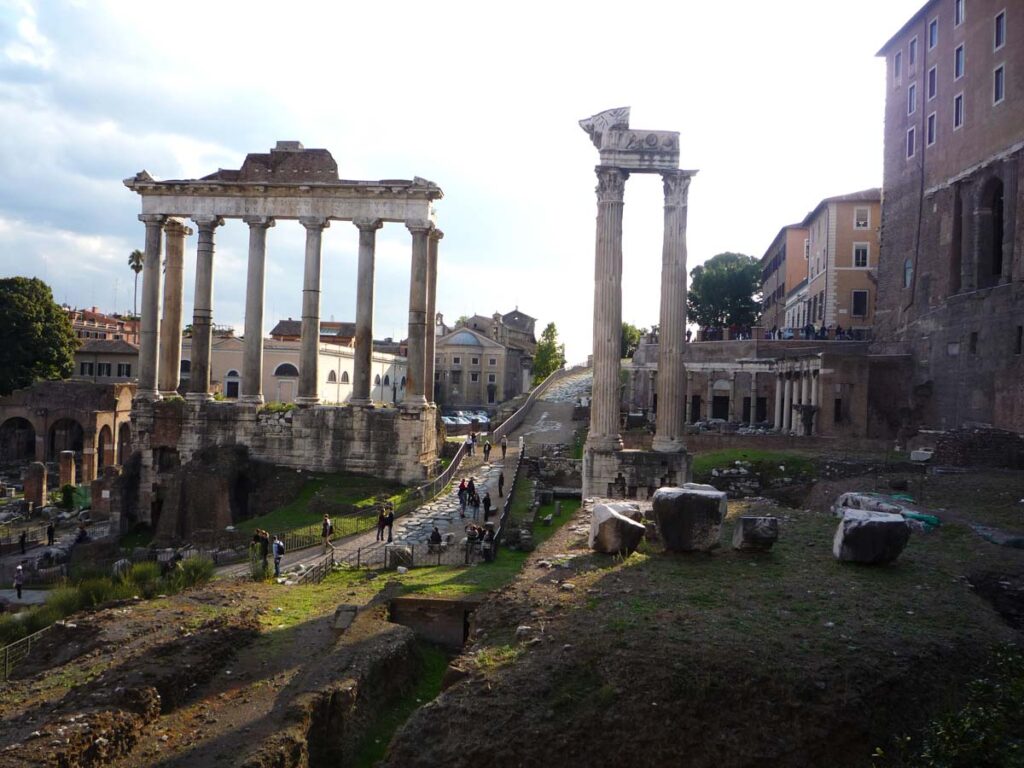
Must-sees at the Roman Forum include the 23 metre-high Arco di Settimio Severo, which was built in AD203 to celebrate Emperor Septimius Severus’s victories in the Roman–Parthian Wars. Don’t miss the Arco di Tito, which is said to have inspired Paris’s Arc de Triomphe. While it isn’t the most impressive site in the park, I was fascinated by the Tempio di Giulio Cesare, which was built by Emperor Augustus in 29BC on the spot where Julius Caesar’s body was cremated 15 years earlier.
Circus Maximus, Rome
It might sound odd, but when I visited Rome I found the Circus Maximus the most atmospheric ancient ruin in the city.
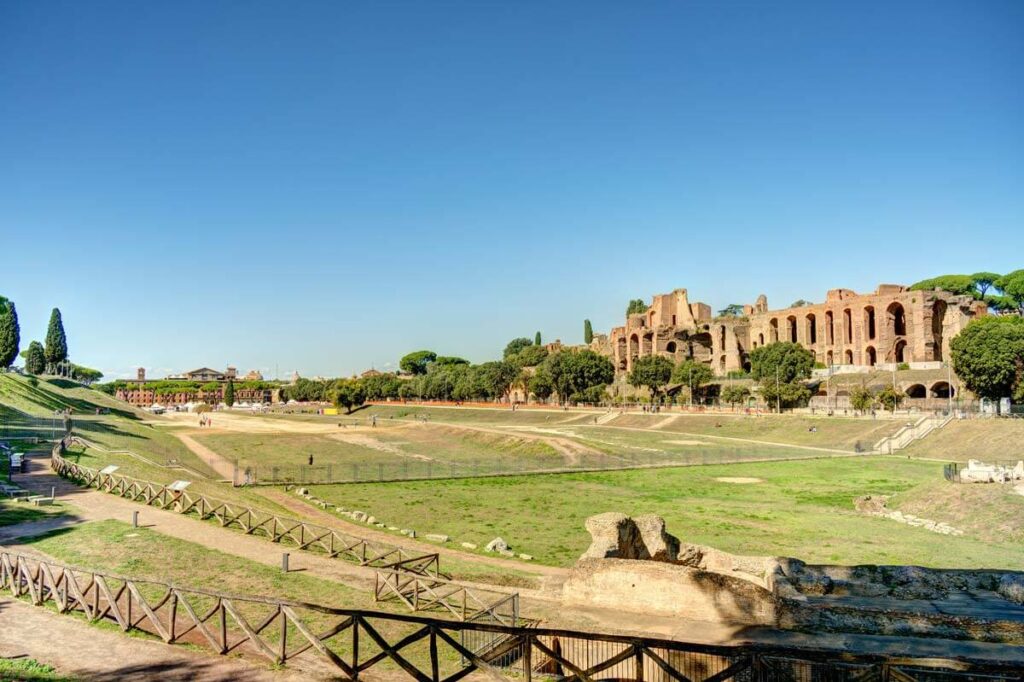
The Circus Maximus in Rome is an ancient chariot racing stadium that dates back to the 6th century BC and was later enlarged on the orders of Emperor Constantine as a show of power. It’s a vast space which could accommodate up to 250,000 spectators around an arena 600 metres long and 140 metres wide – the size of over 15 football fields.
The arena was primarily used for chariot races, but also hosted other public events like gladiatorial contests. Although much of the original structure has been lost over time, the outline of the track is still visible.
Palatine Hill
The Palatine Hill in Rome is one of the city’s Seven Hills and holds a significant place in Roman mythology and history. According to legend, it’s the site where Romulus and Remus, the city’s founders, were raised by a she-wolf. Over time, the hill became an exclusive residential area, housing emperors and aristocrats, including Rome’s first emperor, Augustus, as well as Emperor Tiberius and Emperor Domitian.
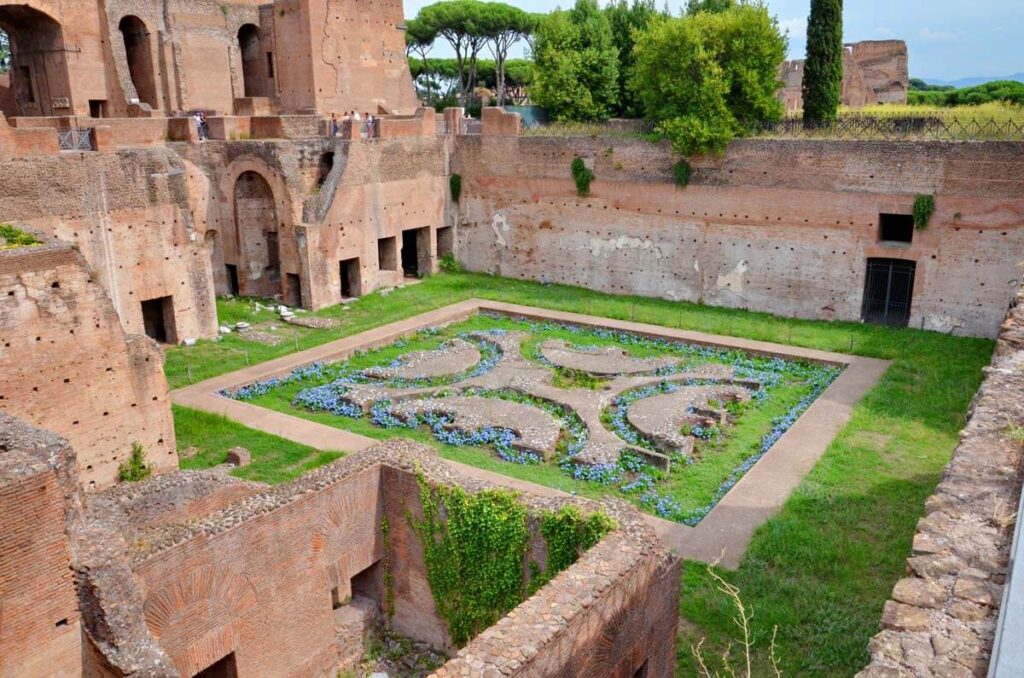
Key attractions include the Flavian Palace and the House of Augustus, filled with well-preserved frescoes. The hill offers panoramic views of the Roman Forum, Colosseum and Arch of Constantine making it a great place to visit to appreciate Rome’s ancient landscape.
Ostia Antica, near Rome
Ostia Antica, located just 30 minutes from Rome, offers a glimpse into everyday life in ancient Roman life. It was Rome’s primary seaport, and the well-preserved ruins include an amphitheatre, baths, and an array of shops and apartments.
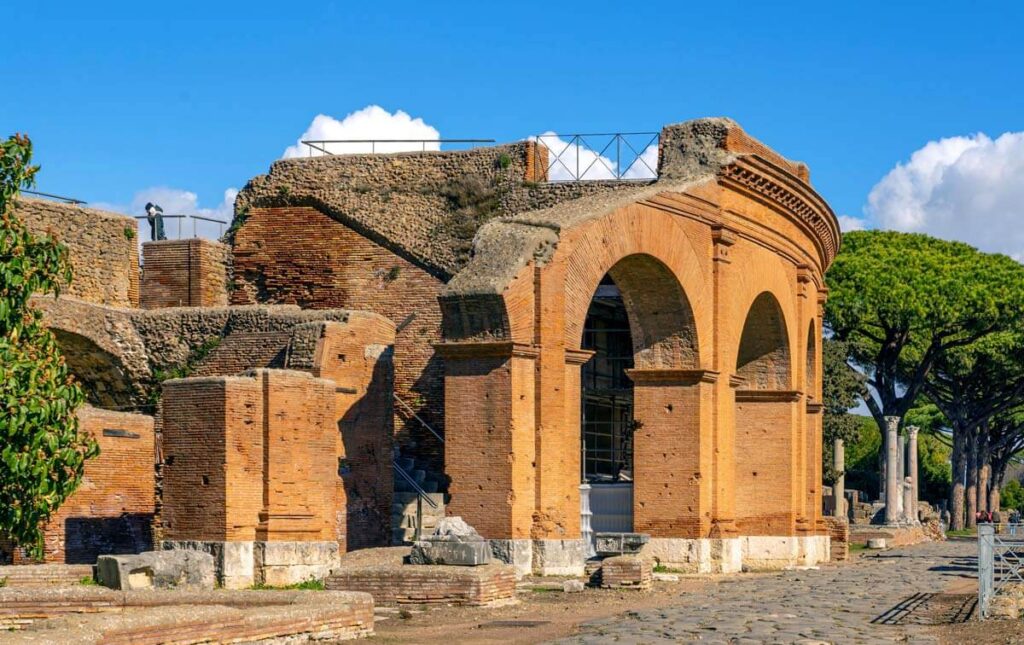
Unlike Pompeii, Ostia wasn’t destroyed by a volcanic eruption, so its decline was gradual, which adds a different layer to its historical narrative. You can wander down its old streets and practically feel the hustle and bustle of traders, sailors, and citizens from thousands of years ago.
Ostia Antica is less crowded than other sites, making it easier to explore at your own pace. While the site isn’t as large or well-preserved as Pompeii and Herculaneum (and experienced some rather questionable reconstruction), it’s a good choice if you don’t have time to travel south to see Pompeii.
More Roman sites in Rome
While the Colosseum and the Roman Forum are the most famous sites in Rome, if you have a bit more time in the Eternal City, don’t miss some of the other wonderful places to walk in the Romans’ footsteps:
- The Pantheon is far from being a ruin, but it can’t be beaten for atmosphere and sheer wonder at the Romans’ architectural skill
- The Theatre of Marcellus is even older than the Colosseum and was started by Julius Caesar
- The Sacred Area of Largo Argentina opened to the public for the first time in 2023; the archaeological site, which is home to several temples, has been designed to be fully accessible so everyone can visit
- The Baths of Diocletian were the largest bath complex in Ancient Rome; they now hold one of Rome’s best-reviewed museums
- The magnificent ruins of the Baths of Caracalla are only a short walk from the Colosseum but are much quieter, so they’re a great choice if you want to avoid the crowds
- The Domus Aurea, or “Golden House”, a lavish palace complex built by Emperor Nero after the Great Fire of Rome in 64 AD which featured gold and jewelled decoration, an artificial lake, gardens, and even a revolving dining room. After Nero’s death, much of the Domus Aurea was destroyed or repurposed, but some rooms remain and can be seen on a guided tour.
- The Castel Sant’Angelo in Rome, originally constructed as the Mausoleum of Hadrian, is a fortress that has played various roles in Rome’s history, including as a papal residence and a military stronghold. Its iconic cylindrical shape and rich history make it a must-visit landmark, and it also offers panoramic views of the city from its terrace.
Pompeii, Naples
Pompeii is an iconic Roman site, 15 miles south of Naples and located in the shadow of Mount Vesuvius, the volcano which destroyed the city in 79AD. Pompeii was a prosperous city, full of public buildings, temples, theatres, bath houses and shops, along with grand villas and ordinary homes. The site is absolutely huge and still growing, as archaeologists make fresh discoveries.
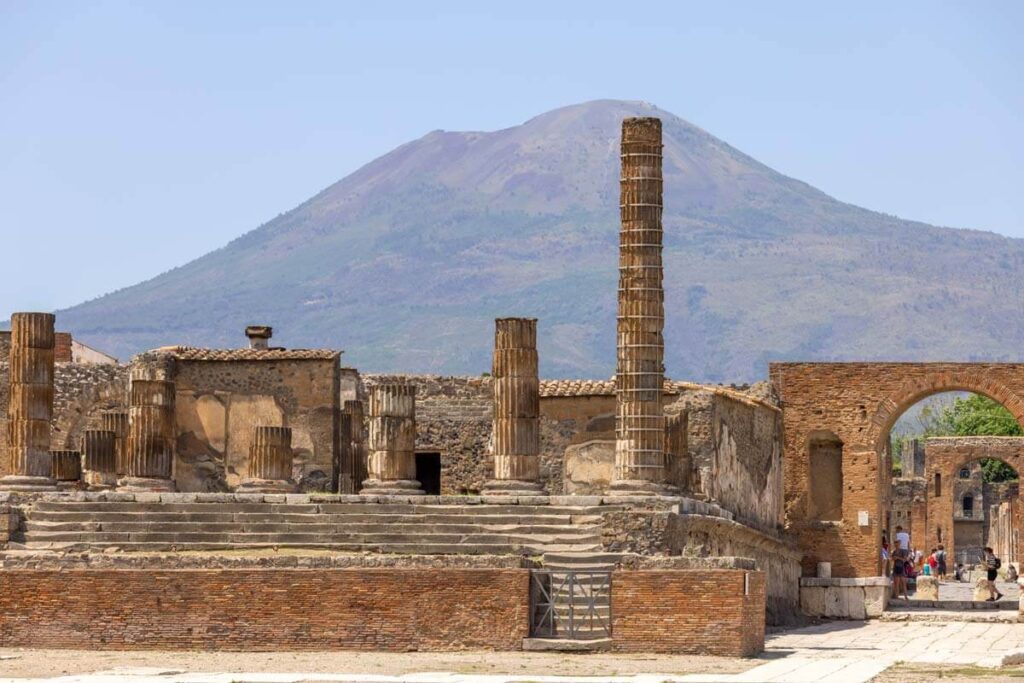
Compared to other Roman ruins, Pompeii is particularly well-preserved as the layers of volcanic rock that flew out of Vesuvius completely buried the city, leaving it just as it was on that fateful day.
With so much to see, visiting Pompeii felt to me a bit like going on a city break back to Roman times. If you want to really feel that you’ve walked in the footsteps of the Romans, a trip to Pompeii should definitely be on your bucket list.
Herculaneum, Naples
Like Pompeii, the town of Herculaneum was destroyed when Vesuvius erupted, but rather than being buried under heavy rocks, Herculaneum was covered in ash, meaning that the buildings there are some of the world’s best-preserved Roman ruins; it’s quite astonishing to think, as you’re walking around, that what you’re seeing is nearly 2000 years old.
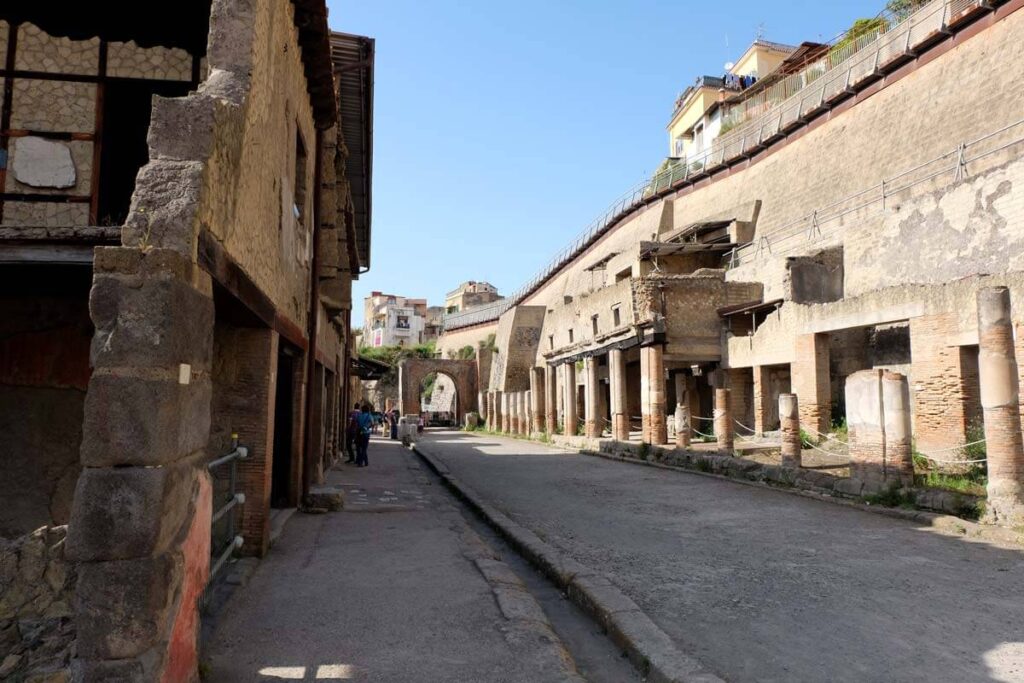
While in Pompeii most buildings were destroyed above their ground floor, in Herculaneum some of the upper floors survived.
Herculaneum is smaller and much less busy than Pompeii, so lots of visitors say they actually prefer it. Visiting Herculaneum is an easy day trip from Naples, Sorrento or the Amalfi Coast, and pairs well with a hike up Mount Vesuvius.
Verona Arena, Verona
The Verona Arena, located in the heart of Verona, Italy, is one of the best-preserved ancient amphitheatres in the world. Built in the first century, it could originally accommodate up to 30,000 spectators. Unlike Rome’s Colosseum, which is partly in ruins, the Verona Arena remains largely intact, giving visitors a more complete sense of what it was like to attend an event in an ancient Roman amphitheatres.
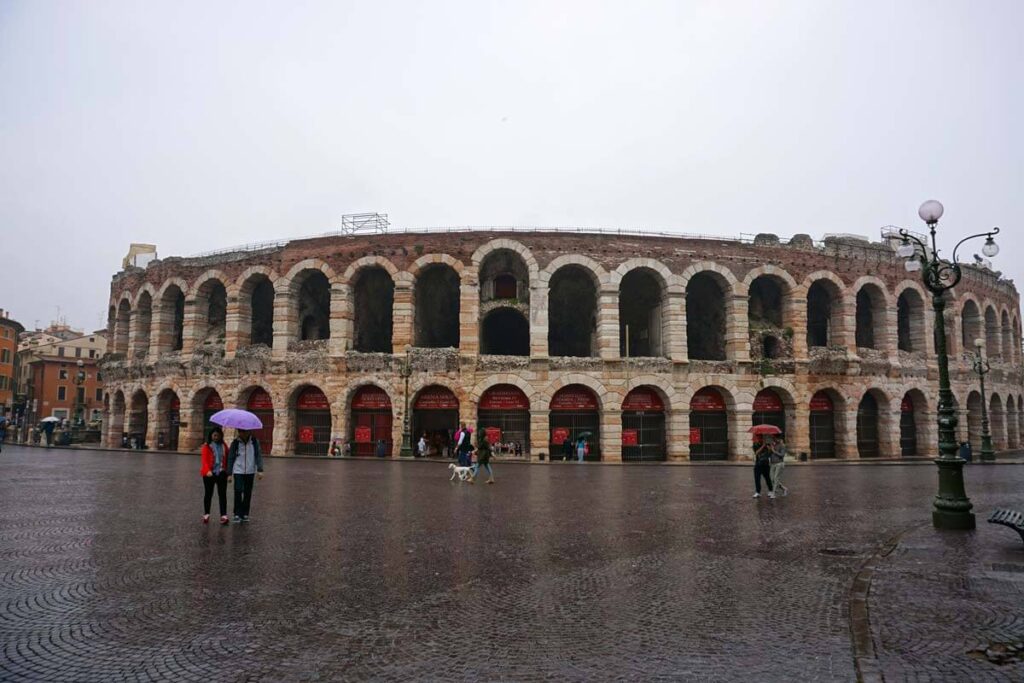
The Arena is still used today for performances, including the famous annual opera festival, which draws crowds from all over the world. If you’re visiting Verona, taking a tour during the day is great, but for the full effect, try to go to one of the performances. The acoustics are exceptional, so even without microphones, the sound carries well; sitting in the audience it’s easy to imagine yourself as an ancient Roman, enjoying the spectacle.
The Grottoes of Catullus, Lake Garda
We’ve imagined ourselves as ordinary Romans in Pompeii and Herculaneum, now let’s see how the other half lived in Ancient Rome. The Grottoes of Catullus, located on the beautiful Sirmione peninsula jutting out into Lake Garda, are not actually grottoes but the ruins of a grand Roman villa. Built around the 1st century AD, the villa had stunning panoramic views of the lake, with the Italian Alps in the distance.
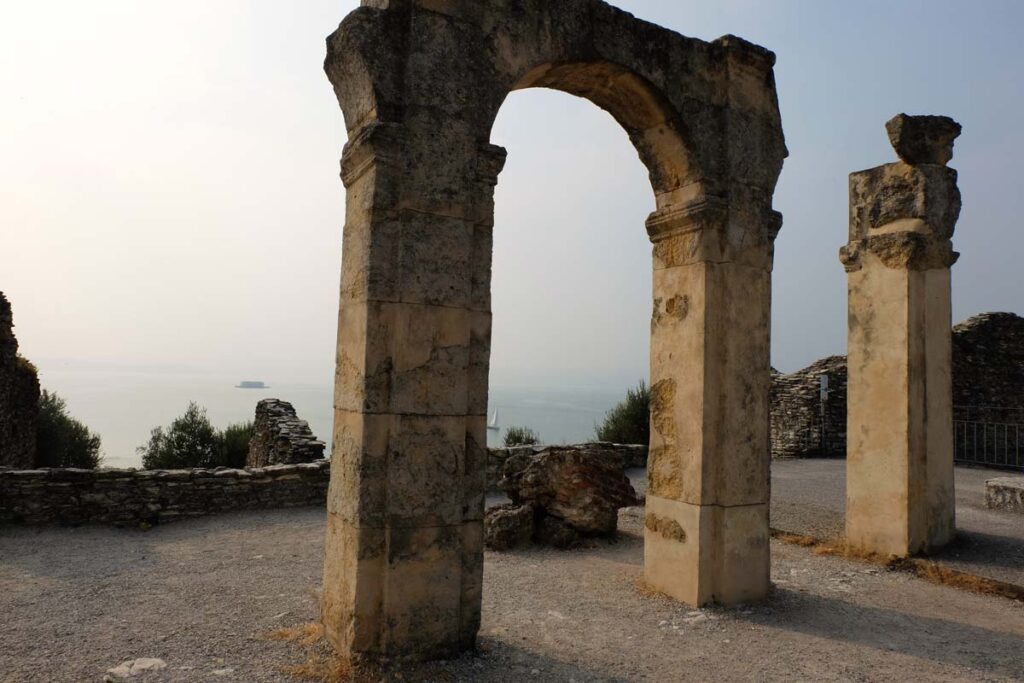
Contrary to its name, the villa is not definitively linked to the Roman poet Catullus, but it’s widely believed he could have spent time here. The site is quite expansive, featuring the remnants of a three-storey structure that includes residential quarters, porticos, thermal baths and a beautiful Olive Grove. Wandering around, I could definitely see myself as a wealthy Roman! There’s a small museum on-site to see artefacts discovered in the area.
Roman sites to visit in Britain
From the heart of the Roman Empire in Italy, let’s go to its most northerly outpost. Julius Caesar had led some small incursions into southern England in 55-54BC, but the Romans began their invasion of Britain in earnest in AD43-47. By AD70 they had conquered most of Wales and the north, and southern parts of Scotland in AD83.
There are hundreds of Roman ruins to visit in Britain (there are two within 20 minutes of where I live!) but there are two in particular that you simply cannot miss.
Hadrian’s Wall, Northumberland
Hadrian’s Wall, stretching across Northern England from the North Sea to the Irish Sea, is a remarkable feat of Roman engineering. Built on the orders of Emperor Hadrian in the 2nd century AD, the wall served as a defensive fortification for the Roman province of Britannia. Originally standing around 15 to 20 feet high and extending for 73 miles, it marked the northern boundary of the Roman Empire in Britain.
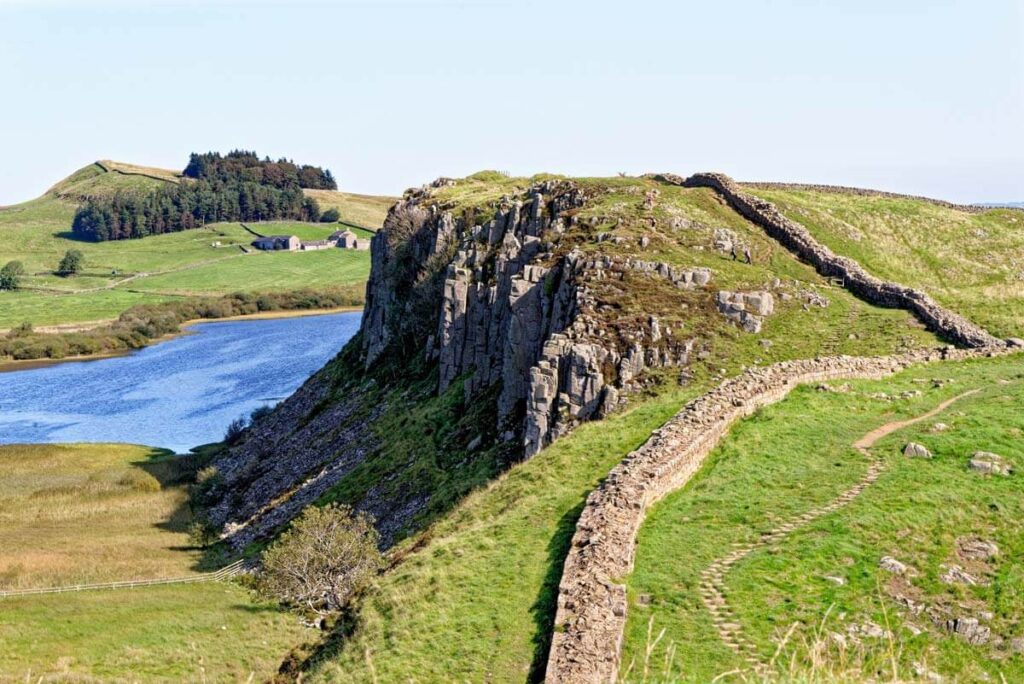
While much of the wall has eroded over time, significant sections still remain. The wall is more than just a barrier; it’s a complex military zone with forts, watchtowers, and settlements, many of which have been excavated and are open to the public.
Walking along the remaining stretches, you can almost feel the presence of the Roman soldiers who once patrolled it. At Housesteads, which is the most complete example of a Roman fort in Britain (and a popular destination for our school trips when I was a kid!), you can see how the 800 soldiers who were stationed here lived and worked.
Chester, Cheshire
In the UK, if a town has “Chester” in its name, then there’s a good chance that there’ll be something Roman to see, and that’s particularly true for the city of Chester. Chester, located in the North West of England, was founded as a fort, or ‘castrum,’ in 79 AD and was one of the main military bases during Roman Britain.
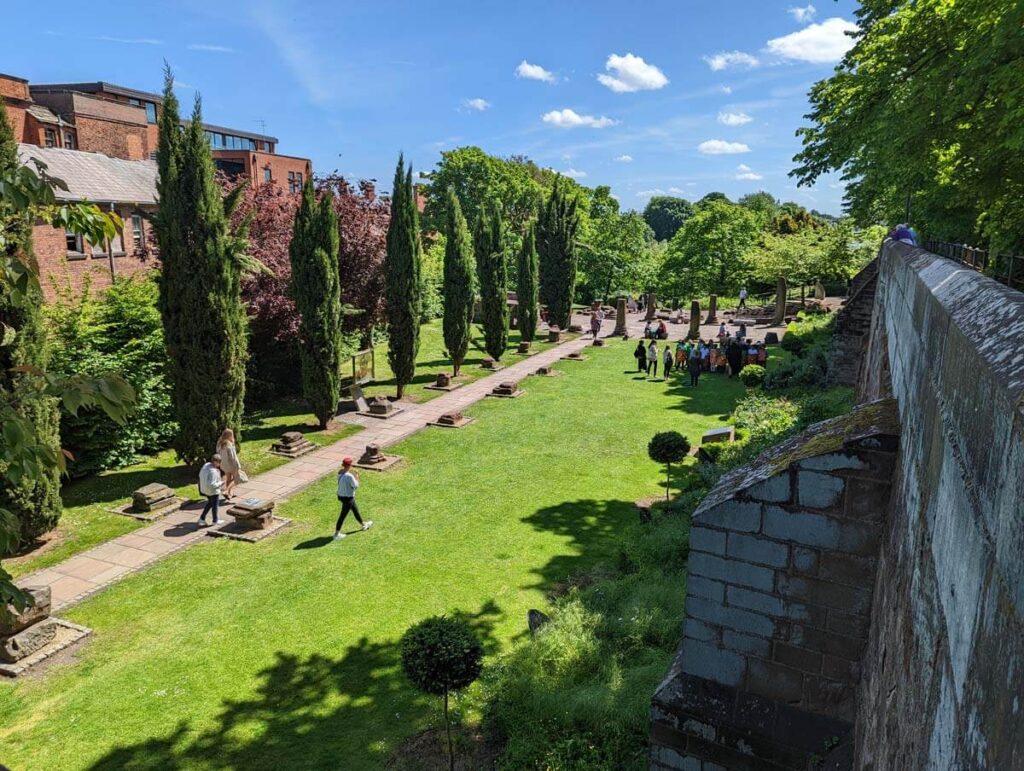
The city is perhaps best known for its Roman walls, the most complete in Britain, which you can walk along for nearly 2 miles, through the city, past the lovely cathedral and above Chester’s famous galleried shopping area, called the Rows. Parts of these walls even incorporate the original Roman masonry. Another highlight is the Roman amphitheatre, the largest stone-built example in the UK. It could hold up to 8,000 spectators and was likely used for military training as well as public spectacles.
The Deva Roman Experience museum has a reconstructed Roman street and hands-on exhibits, ideal for families and anyone keen to walk in the footsteps of the Romans.
The Roman Baths, Bath
The Roman Baths in Bath, England, are one of the best-preserved Roman spa complexes in the world. Built around natural hot springs, the site was a significant centre for relaxation and healing in Roman Britain. Constructed in the 1st century AD, the baths were part of a larger complex that included a temple dedicated to Sulis Minerva, a goddess revered for her healing powers. The baths show a unique blend of Roman and Celtic influences, as the invading Romans picked up elements of Celtic culture.
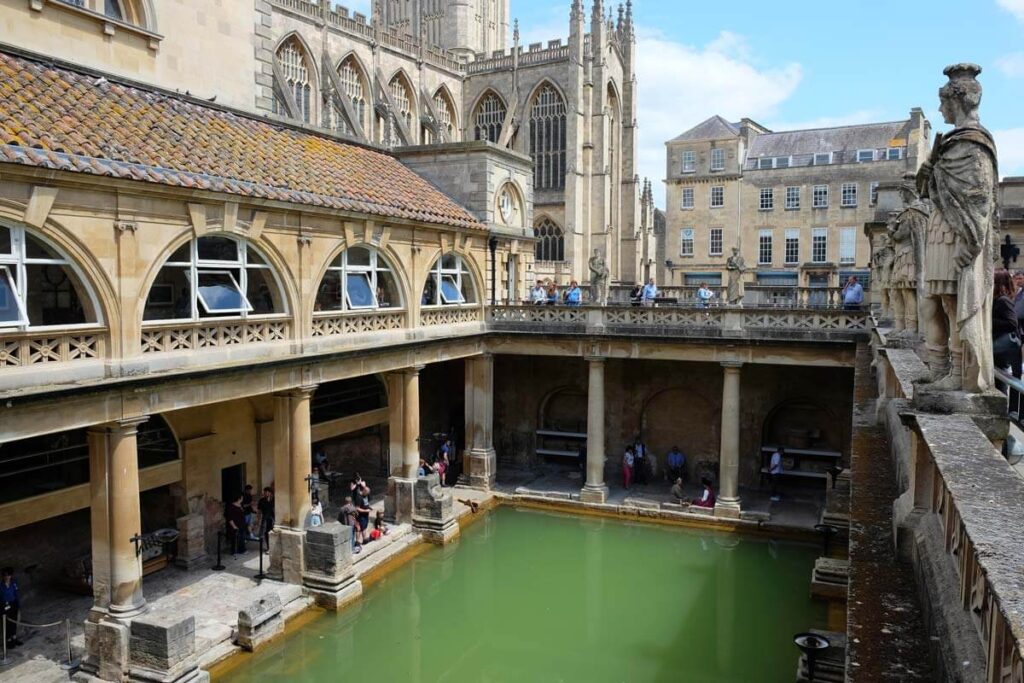
Today, the Roman Baths are one of the top things to do in Bath. Visitors can explore the Great Bath, which still contains the mineral-rich water, as well as the Sacred Spring, where offerings to the goddess were made. There’s also an extensive museum that showcases numerous discoveries, including the famous “curse tablets”, which are lots of fun to read!
Unfortunately it’s not possible to actually bathe in the Roman Baths, but you can indulge yourself with a visit to Bath’s Thermae Bath Spa, which uses water from one of Bath’s other hot springs.
Roman sites in France
From the north of England, lets head to the south of France. The Occitanie and Provence regions are home to many of France’s best preserved Roman sites.
Pont du Gard, near Nîmes
The Pont du Gard is an ancient Roman aqueduct in southern France. Built in the first century AD, it’s an engineering marvel and one of the most impressive ancient Roman structures in Europe.
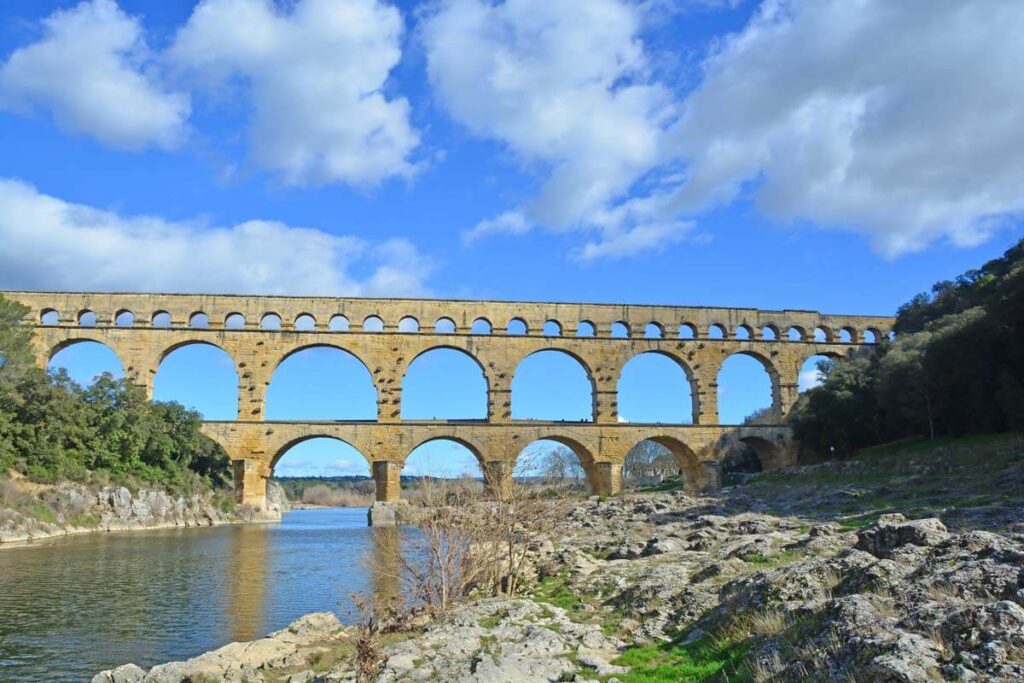
Rising to a height of 48.8 metres, it spans the Gardon River and consists of three tiers of arches. The craftsmanship is so precise that the massive limestone blocks were fitted without mortar, and it’s not surprising that it’s now a UNESCO World Heritage site.
Just a short distance away, the city of Nîmes boasts some of the most beautiful and impressive ancient Roman sites in Europe. The Amphitheatre of Nîmes could originally hold up to 24,000 spectators and featured a range of events from gladiator fights to public executions, while the Maison Carrée is a stunning Roman temple.
Théâtre Antique d’Orange, Orange
The Théâtre Antique d’Orange is one of the best preserved Roman ruins in France. Built in the early 1st century AD, it could accommodate up to 10,000 spectators and was primarily used for theatrical performances and musical shows.
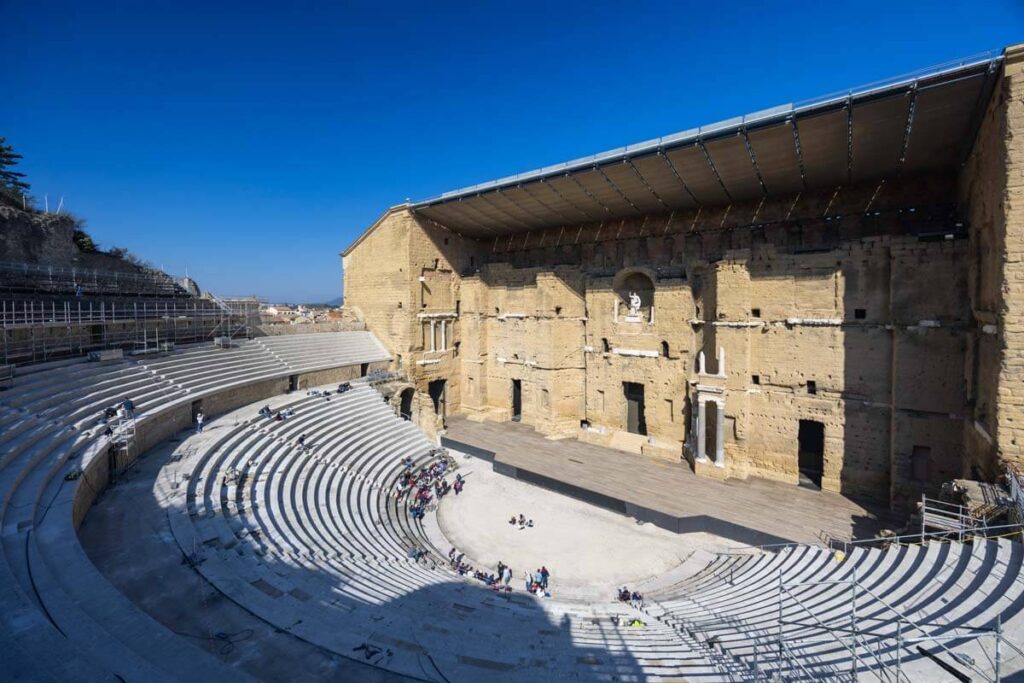
The theatre’s most striking feature is its enormous stage wall, which enhances the venue’s acoustics and provides a stunning backdrop for performances. Today, the theatre is not just a historical site but also hosts live events like the renowned Chorégies d’Orange opera festival.
Roman ruins in Greece
While you might be keener to see ancient Greek ruins when you’re in Greece, there are some beautiful Roman ruins to see too. The Roman presence in Greece can be traced back to the 2nd century BC, starting with the Roman victory over the Kingdom of Macedonia in the Macedonian Wars and ending with Greece becoming a province of the Roman Empire by 27BC.
Roman Agora, Athens
The Roman Agora, located in the shadow of the Acropolis in Athens, was constructed in the 1st century BC. Funded by Julius Caesar and Augustus, it served as the new commercial centre of the city, taking over many functions of the older Greek Agora.
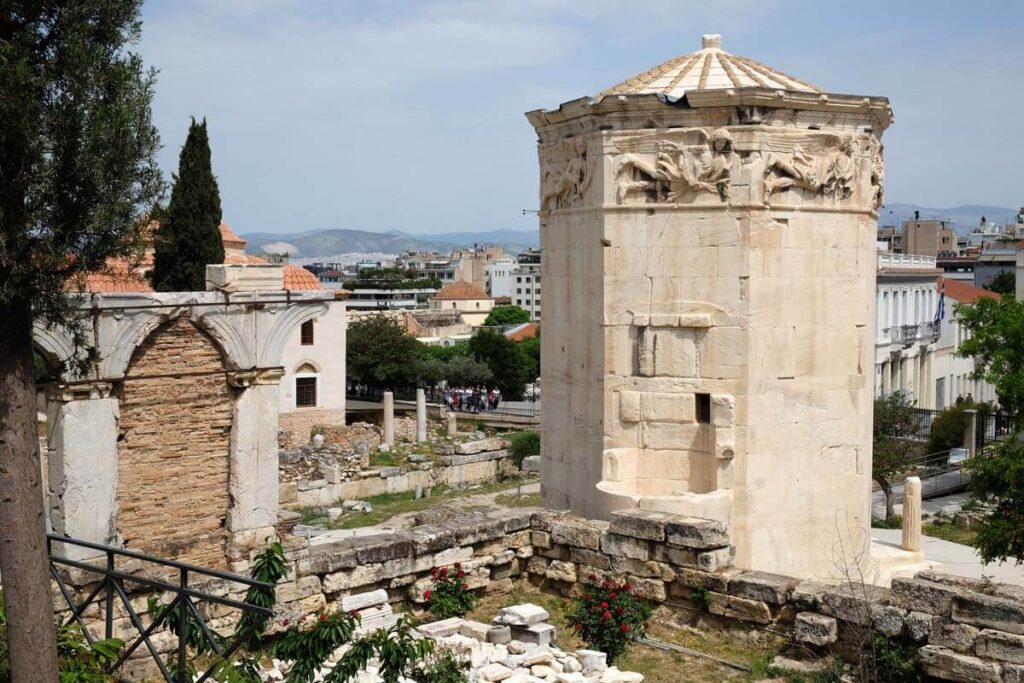
The Roman Agora is known for its Gate of Athena Archegetis, a grand entrance made up of four Doric columns, and for the Tower of the Winds, a beautiful octagonal marble clocktower that also served as a weather vane and calendar.
Roman Agora and Arch of Galerius, Thessaloniki
The Roman Agora in Thessaloniki, Greece, built in the 2nd century AD, served as the city’s social and commercial hub. Today, it offers a glimpse into urban life in the Roman Empire with its well-preserved remains, including a theatre and shops.
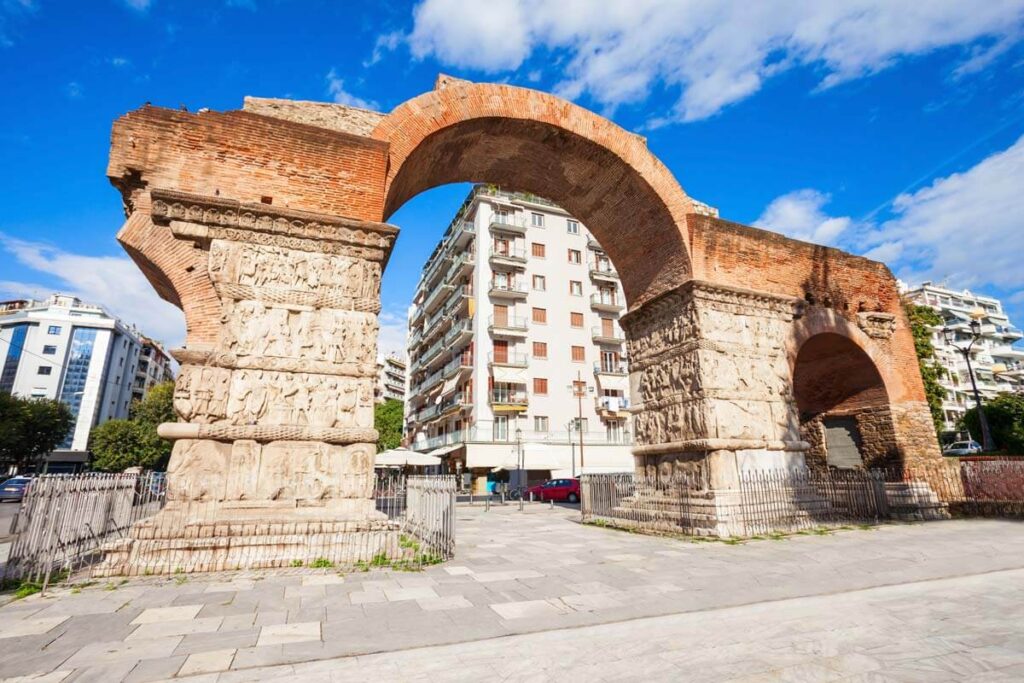
Nearby stands the triumphal Arch of Galerius, constructed in the early 4th century AD to commemorate Emperor Galerius’s victory over the Persians. This triumphal arch is renowned for its intricate reliefs depicting scenes from the campaign.
Roman ruins in Germany
Germany is more often associated with fairytale castles than Roman archaeological sites, but there are some great Roman places to see in Germany. Germany was never fully integrated into the Roman Empire, but the Romans did make significant inroads, particularly along the Rhine River, which served as a natural frontier for the empire.
The region was largely occupied by various Germanic tribes, and the Romans established military camps and trading outposts to control and defend their territory.
Fortress of Saalburg, near Frankfurt
Saalburg is a reconstructed Roman fort located near Bad Homburg in Germany. Originally built around 90 AD, it served as part of the Limes Germanicus, a line of border fortifications separating the Roman Empire from the Germanic tribes. The Saalburg housed around 600 Roman soldiers and acted as a strategic base for patrols.
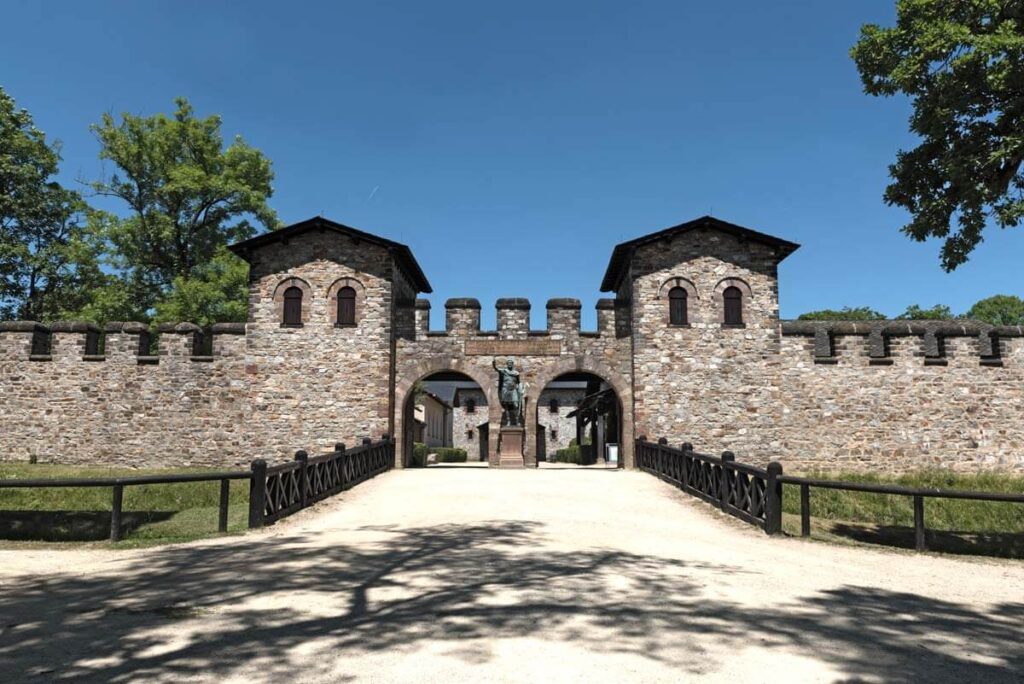
Abandoned in the 3rd century, the ruins were excavated and rebuilt in the early 20th century – the only one in the world to be so fully reconstructed. Today, it operates as a museum, offering visitors a unique chance to explore how Roman centurions lived, worked and defended the edges of the Roman empire.
Porta Nigra
The Porta Nigra, or ‘Black Gate’, is an enormous Roman city gate located in Trier, Germany’s oldest city. Built around 170 AD from sandstone blocks without mortar, its name comes from the darkened colour of the stone caused by centuries of exposure. Originally part of a larger fortification, it was used for both defensive and administrative functions.
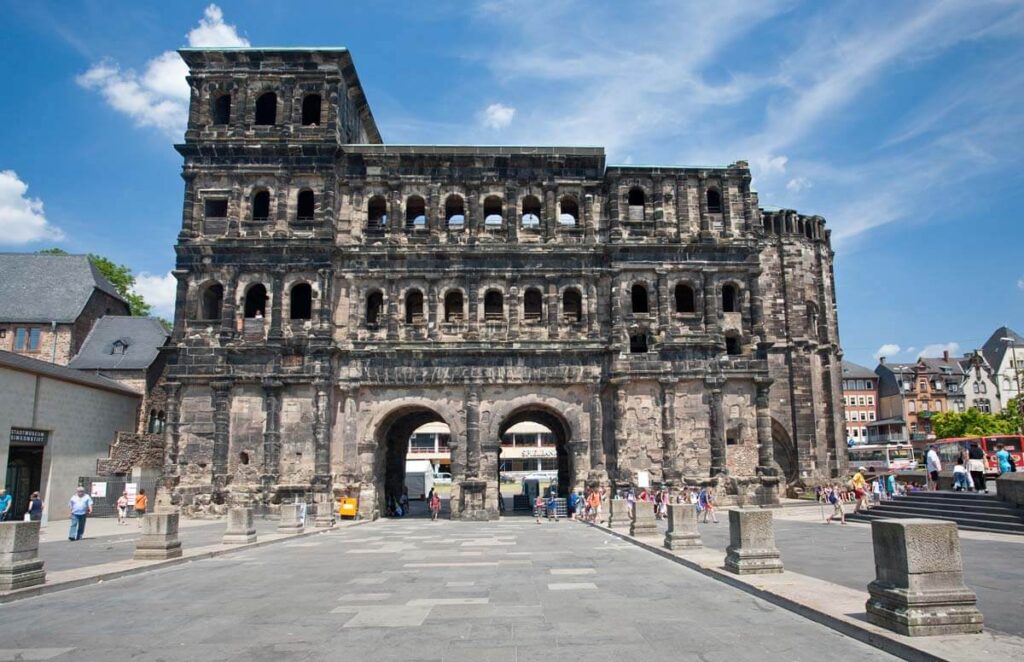
During the Middle Ages, it was transformed into a church, which likely saved it from destruction. Today, the Porta Nigra is a UNESCO World Heritage Site and one of the best-preserved Roman gates in existence. It offers visitors an authentic glimpse into Roman architecture and engineering.
Roman sites in Spain
The Romans arrived in Spain in the 3rd century BC and their influence lasted for over six centuries, shaping the region significantly. Known as Hispania under Roman rule, Spain was a crucial source of minerals, particularly silver, and became a vital part of the Roman economy. Cities like Seville, Barcelona, and Tarragona were established during this period, and their Roman heritage is still visible today.
Aqueduct of Segovia
The Aqueduct of Segovia is one of the best-preserved Roman aqueducts in Europe. Built around the 1st century AD to transport water from the Rio Frio river to the city, this engineering marvel spans 818 metres and is built of over 20,000 granite blocks, held together without mortar.
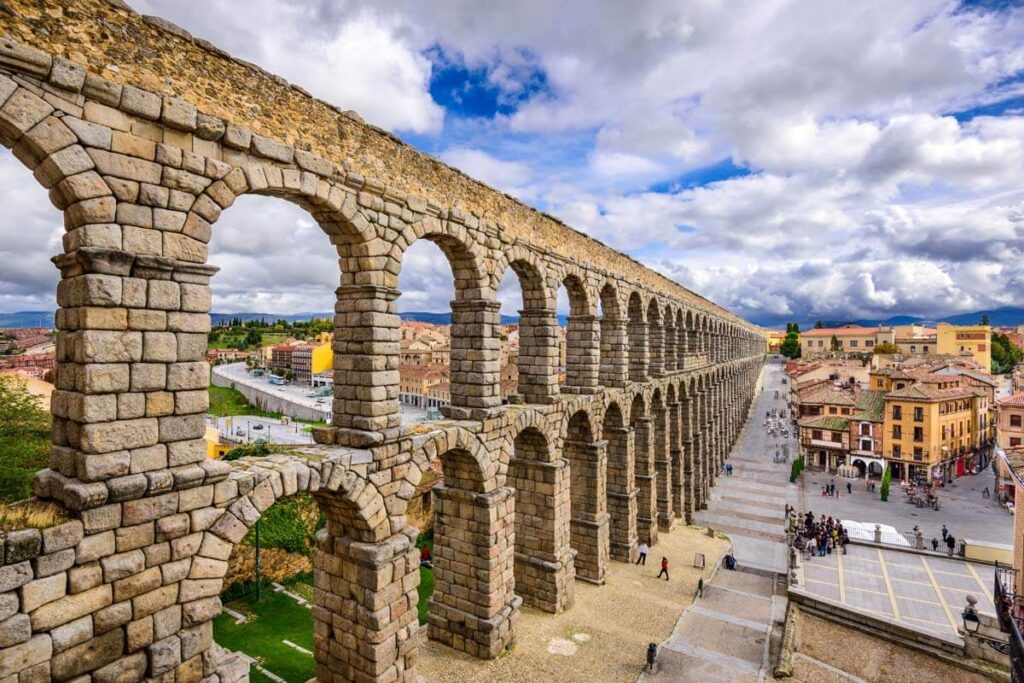
With its highest point reaching 28.5 metres, the structure comprises an astonishing 167 arches in two tiers. Now a UNESCO World Heritage Site, the ancient aqueduct is a must-visit for anyone travelling to Segovia.
Tarraco, Tarragona
Tarraco, now modern-day Tarragona, was a significant Roman settlement in Spain’s Catalonia region and served as the capital of the Roman Empire in the Iberian peninsula. As a vital port and administrative centre, its UNESCO-listed ruins offer a rich glimpse into Roman life.
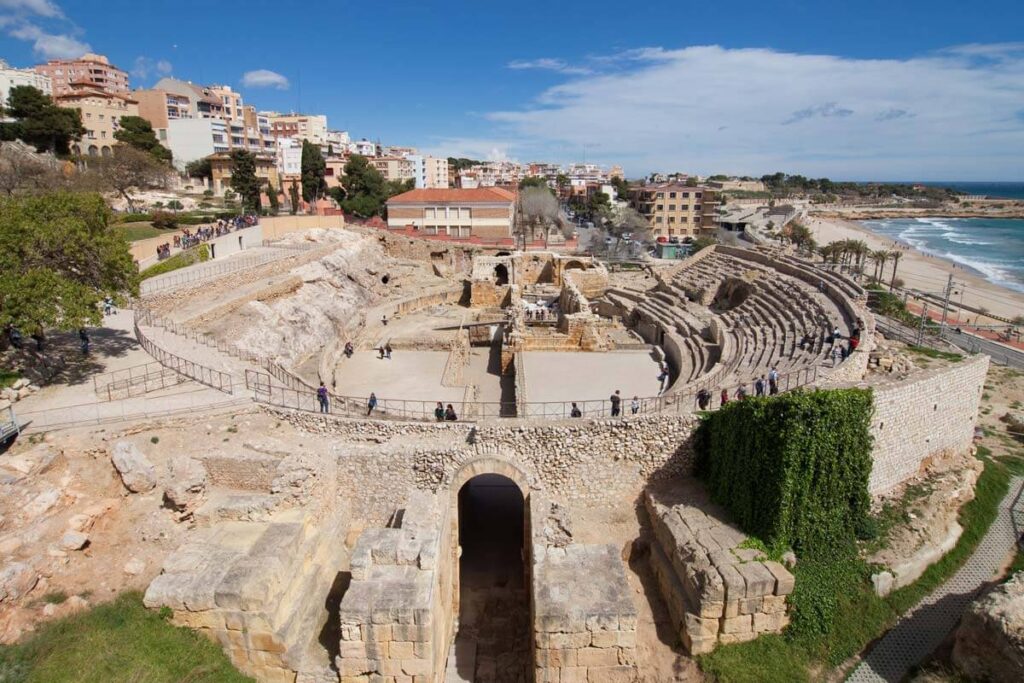
The seaside amphitheatre, which was capable of hosting 14,000 spectators at gladiatorial contests and public events is still an impressive sight. The city’s Roman walls, initially built in the 3rd century BC, are around four kilometres long and remain largely intact.
Mérida
Mérida, located in the Extremadura region of Spain, has one of the largest and most important archaeological sites in Spain. Mérida was once the Roman city of Emerita Augusta and was founded in 25 BC by Roman Emperor Augustus to provide homes for soldiers who had fought in the Cantabrian Wars. The city served as the capital of the Roman province of Lusitania and was among the largest cities in Hispania.
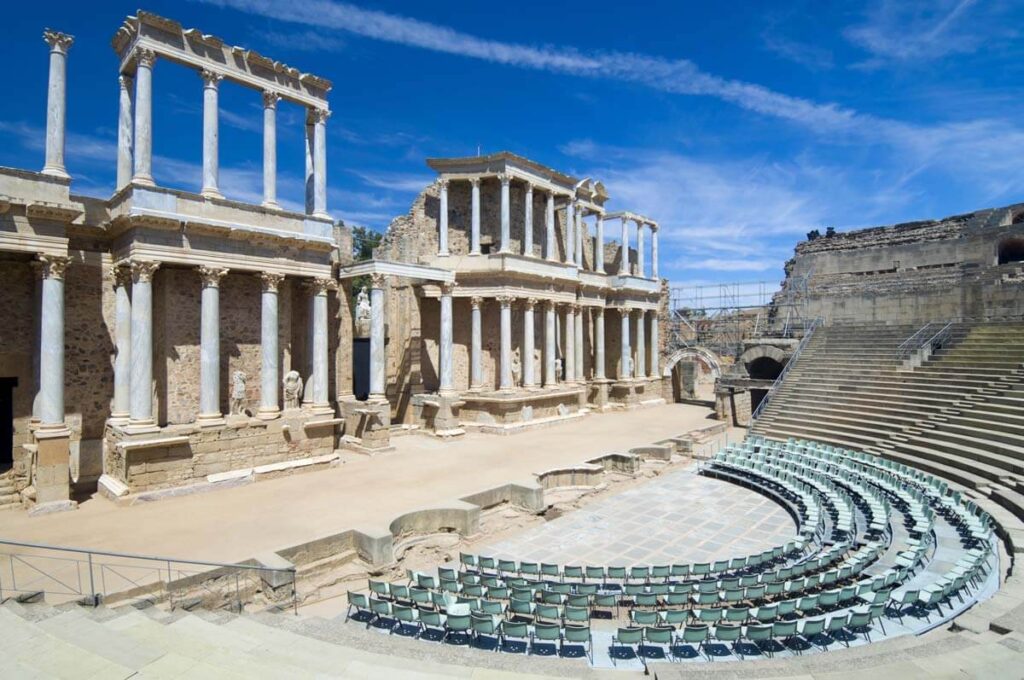
Today, it’s renowned for its extensive and well-preserved Roman ruins and is one of the most-visited ancient sites in Spain. Roman ruins to visit in Mérida include the Roman Theatre, which was capable of holding 6,000 spectators and still hosts performances during the Mérida Classical Theatre Festival. Mérida’s Roman Bridge, which spans the Guadiana River, is one of the longest of its kind.
The city is also home to the National Museum of Roman Art, which displays a collection of artefacts found in and around Mérida.
Antiquarium, Seville
The Antiquarium of Seville is an underground museum located in the city centre, underneath the famous Metropol Parasol. The Antiquarium showcases Roman and Moorish ruins that were discovered during construction work in 2009 and gives a glimpse into Seville’s ancient past.
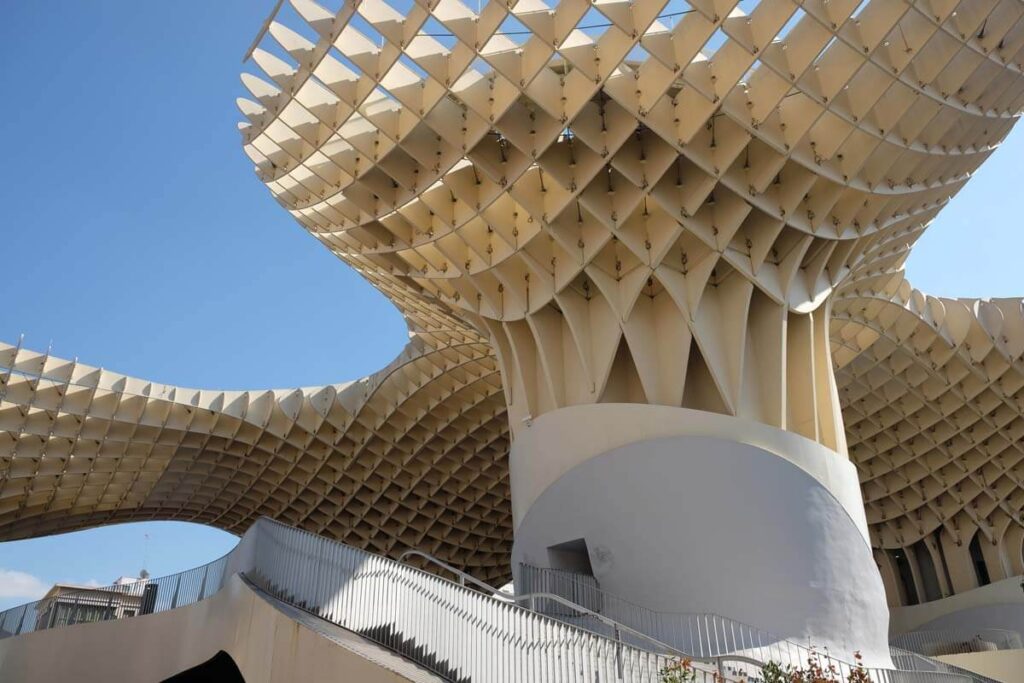
If you visit the Antiquarium you’ll be able to see well-preserved Roman mosaics, pieces of the city walls and even a Roman-era fish salting factory.
Roman ruins in Croatia
The Romans first arrived in what is now modern-day Croatia during the 1st century BC, initially focusing on the coastal areas and the Adriatic Sea before extending their control inland. Today, visiting Croatia’s Roman sites are some of the most popular things to do in Croatia.
Amphitheatre of Pula
The Pula Amphitheatre, often referred to as the Arena of Pula, is one of the most impressive Roman amphitheatres in Europe and a popular tourist attraction. Built during the 1st century AD, it could accommodate up to 20,000 spectators and was primarily used for gladiator fights and other public spectacles.
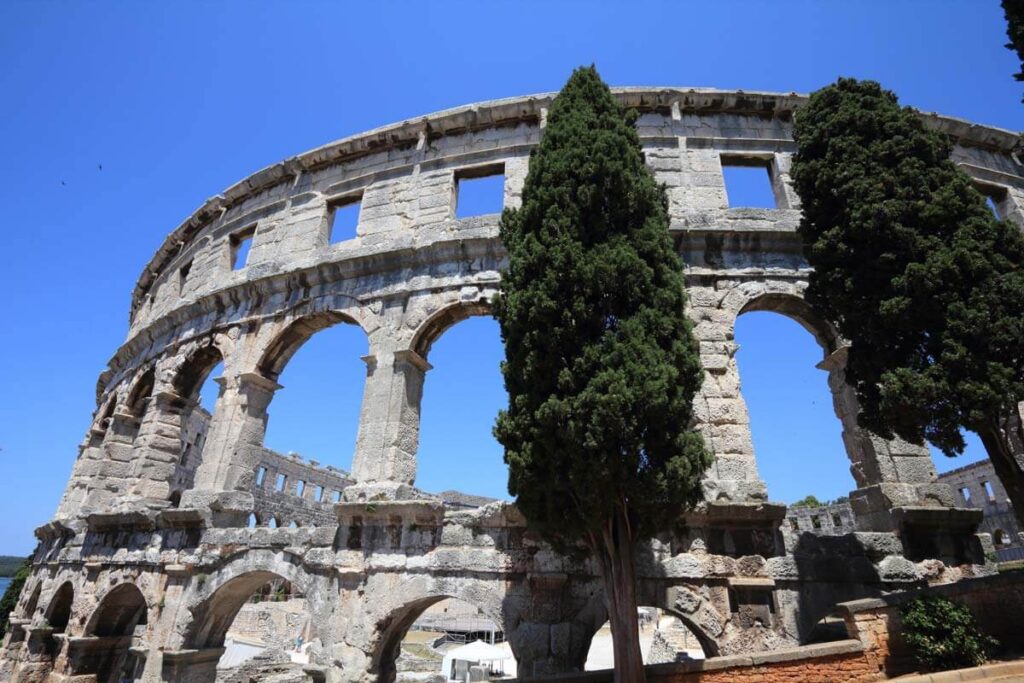
The amphitheatre’s oval shape and towering outer walls are constructed from local limestone, and it features an underground section that once housed animals and gladiators before contests. It’s still used today for concerts and cultural events.
Diocletian’s Palace, Split
Diocletian’s Palace in Split, Croatia, is an extraordinary example of Roman architecture, built between the late 3rd and early 4th centuries AD. Commissioned by Emperor Diocletian as a retirement residence, the palace is more like a fortified town. Its layout consists of a rectangular shape with two main streets which cross at a central square. If you visit, you’ll be able to see intricately carved columns, sphinx statues from Egypt, and a mausoleum that later became the Cathedral of Saint Domnius.
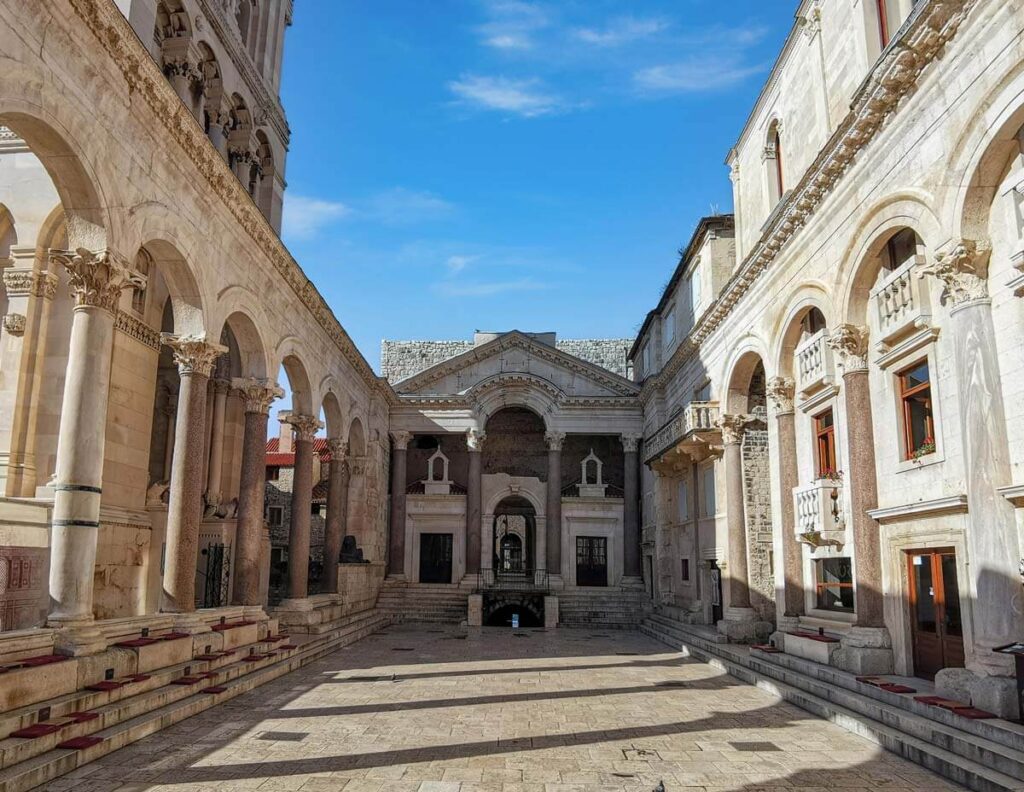
Over the years, the palace has been integrated into Split’s old town, with apartments, shops, and cafes occupying many of the ancient Roman chambers. Like many of the places to visit on this list of the best places to see Roman ruins, it’s also a UNESCO World Heritage site.
Roman sites in Turkey (Türkiye)
Turkey, which was known as Asia Minor, was a significant region in the Roman Empire, with important cities like Troy (yep, the one with the horse). If you’re in Turkey on holiday, there are lots of Roman sites that you can visit, and many of them are easy day trips from the resorts on the coast.
Ephesus, near Kuşadası
Along with Pompeii, Ephesus is my favourite Roman site that I’ve been to, and the first one I visited outside the UK. I went to Ephesus when I was a fresh-faced 18 year old who should have been more interested in drinking on Kusadasi’s bar street than dragging my friend around ancient Roman ruins!
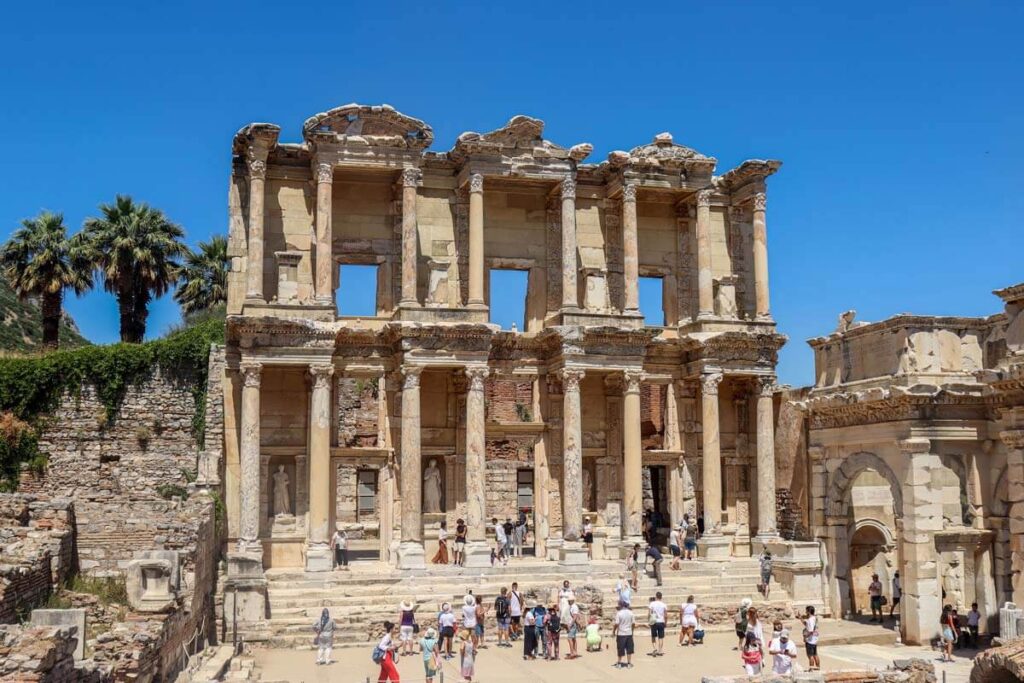
Ephesus was one of the most important cities in the Roman Empire. Established as a Greek colony in the 10th century BC, it became a major Roman city, renowned for its grand architecture and as a centre for trade and learning. The site is home to many remarkable ruins, but the beautiful Library of Celsus is the most famous building in the old city. Today, Ephesus is a UNESCO World Heritage site and an easy day trip from the resorts on Turkey’s Aegean Coast.
Side, Mediterranean Coast
Side, situated on Turkey’s southern coast, is a resort town that’s also a treasure trove of Roman history. Originally a Greek settlement, it flourished under Roman rule from the 1st century BC. Among its most impressive ruins is the ancient theatre, capable of seating around 15,000 to 20,000 spectators.
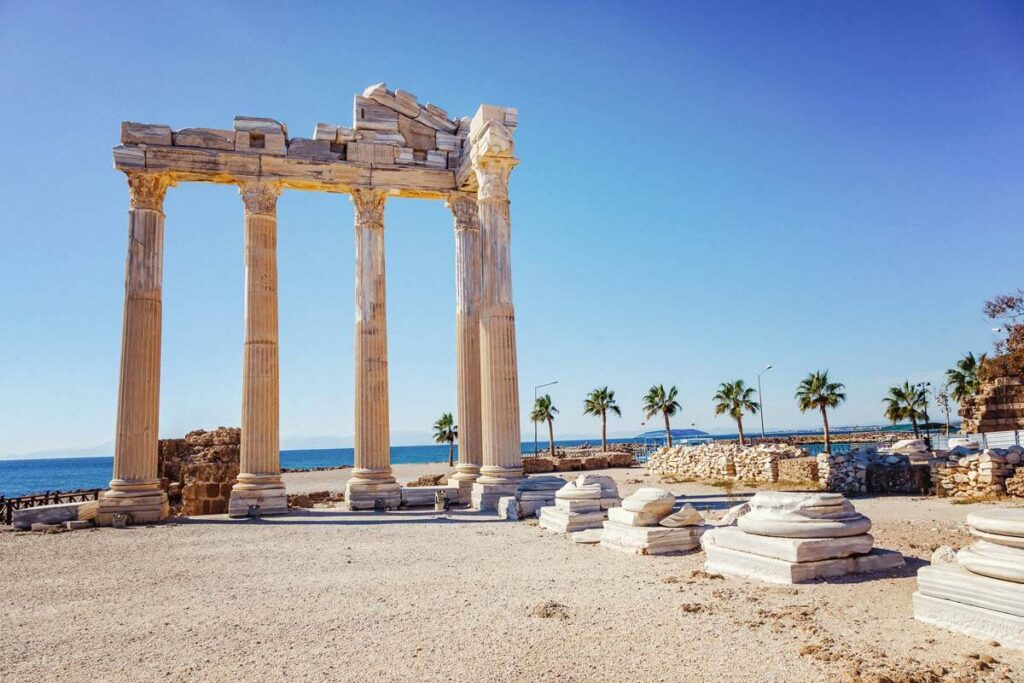
Another notable Roman landmark in Side is the Temple of Apollo, which stands near the harbour and offers stunning sunset views. There are also remnants of Roman baths, agora, and a nymphaeum (fountain).
Hierapolis, southwestern Turkey
Hierapolis has one of the most beautiful and dramatic locations of all the Roman sites on this list. Located in southwestern Turkey, you can find the ruins of the ancient city on the hill above the white travertine terraces at Pamukkale. The pools at Pamukkale are filled with natural thermal water, and it was the hot springs that attracted the Romans to the area.
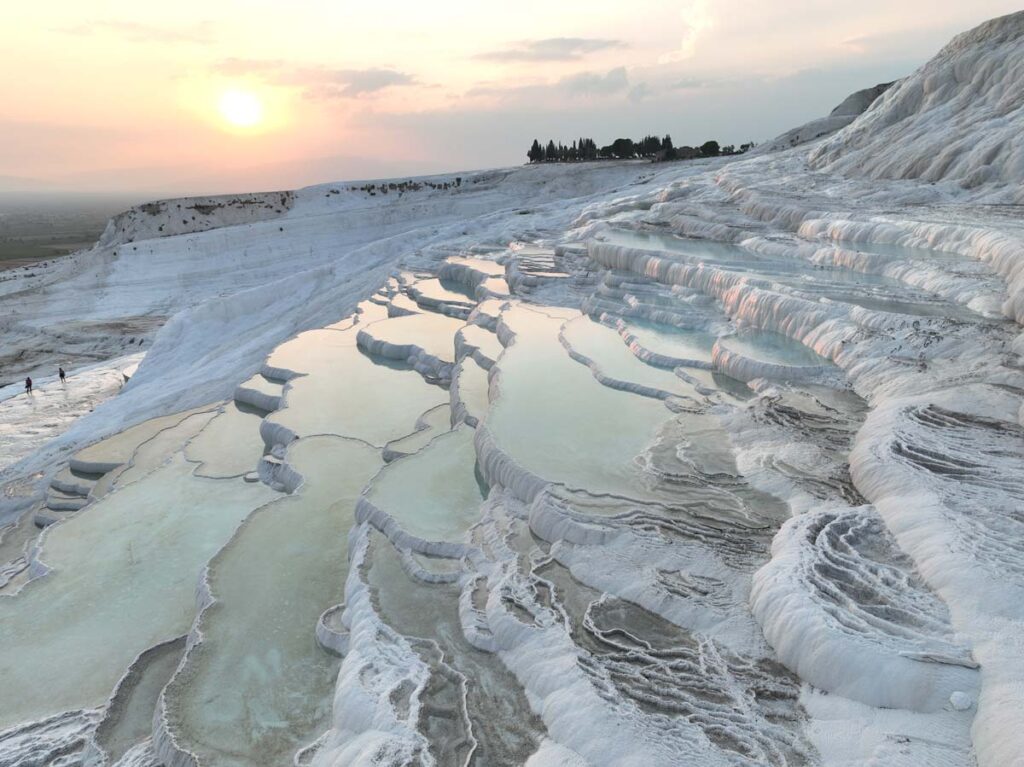
The archaeological site at Hierapolis boasts a well-preserved ancient theatre, Roman baths, and a grand necropolis with over 1,000 tombs. Hierapolis is a UNESCO World Heritage Site, visited both for its remarkable Roman ruins and its unique natural features. Visiting Hierapolis and Pamukkale is an easy day trip from coastal resorts.
More places to walk in the ancient Romans’ footsteps in Europe
Sofia, Bulgaria
In Sofia, the capital of Bulgaria, remnants of its Roman past as the town of Serdica are still visible and integrated into the modern city centre. The partially-excavated site of the Serdica Amphitheatre can be seen in the basement of the Arena di Serdica Boutique Hotel (the hotel appears to be closed but recent reviews say you can see it through the windows).
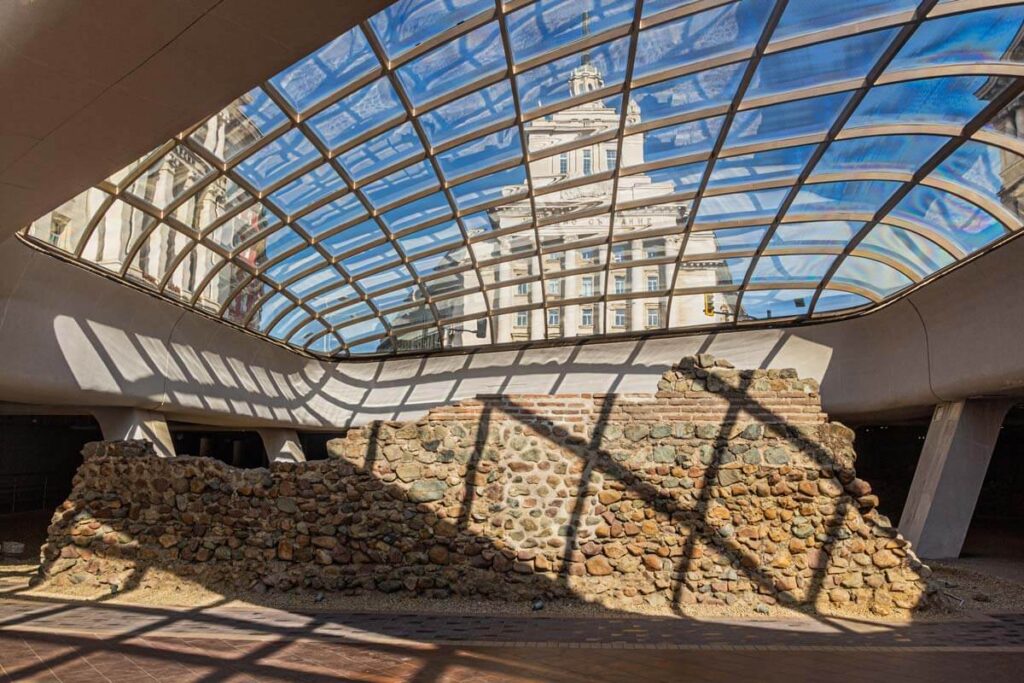
If you’re in Sofia, then don’t miss visiting Serdica Metro station. The modern railway station is in the heart of what was Serdica; you’ll walk through part of the excavated town to get to your train.
Conimbriga, Condeixa-a-Nova, Portugal
Conimbriga is one of the largest and best-preserved Roman settlements in Portugal, located near the city of Coimbra. Dating back to the 2nd century BC, the site was partially abandoned during the 5th century AD due to invasions.
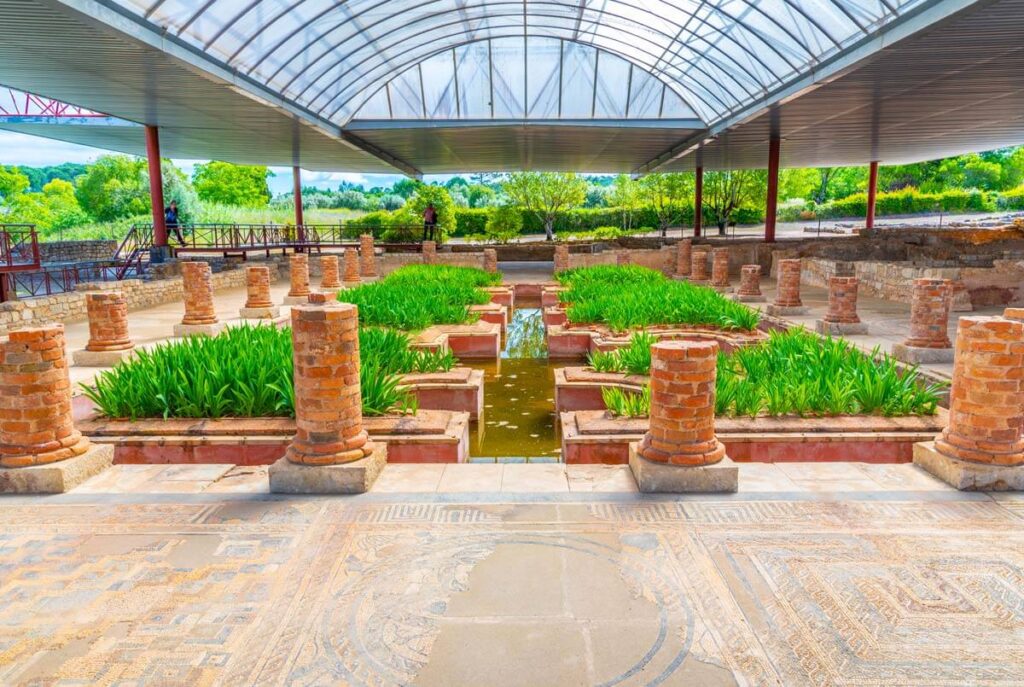
The highlight of Conimbriga is its extensive collection of mosaic floors, displaying intricate patterns and vivid colours. You’ll also find well-preserved building foundations, including those of residential homes and public baths. The site also features a forum, a basilica, and defensive walls that were built during later stages of occupation.
Final thoughts on the best Roman sites to visit in Europe
I hope you’ve found this list useful, and perhaps added a few more Roman sites to your travel plans! If your favourite Roman town, amphitheatre, fort, temple or villa isn’t on this list, then please tell me about it in the comments!

